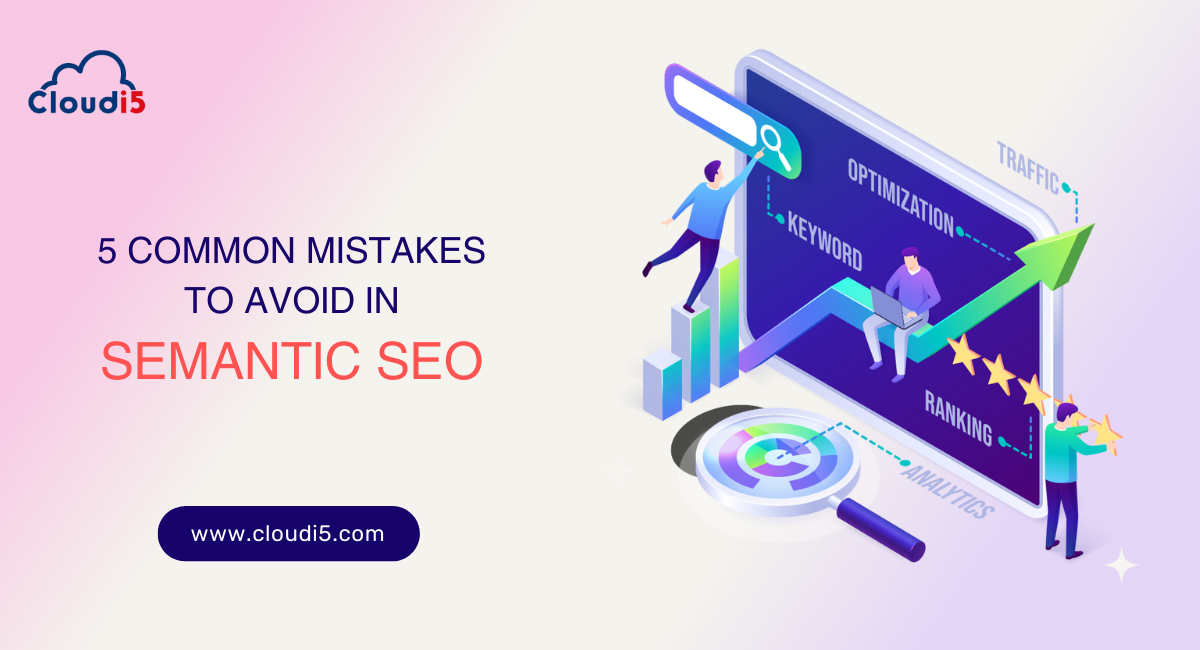
5 Common Mistakes To Avoid In Semantic SEO
For your website to rank higher in search results and be more visible, you must fully utilize Semantic SEO. To improve exposure and rankings on search engines, building SEO websites entails adopting well-structured content, optimizing meta tags, and guaranteeing a seamless user experience. Still, there are many obstacles in the way of semantic excellence, and even the most well-meaning marketers might end up failing miserably. To make sure your strategy not only meets but surpasses expectations, we'll walk you through the nuances of Semantic SEO in this comprehensive tutorial and highlight the five frequent pitfalls you must avoid. Undervaluing the significance of including user intent in your content optimization plan is one of the typical mistakes to avoid in Semantic SEO. When optimizing content for digital marketing services, it is common to miss user intent, which might result in a discrepancy between what users expect and what is actually offered. This error may be avoided by using professional SEO services for a more sophisticated approach. So grab a seat, and let's explore the ins and outs of a smoothly optimized online presence while avoiding the dangers that could throw off your SEO efforts.
1. Overlooking user intent:
Not Carrying out Detailed Research:
Issue: Not fully investigating and comprehending the variety of ways consumers convey their search intent.
Solution: Take the time to conduct in-depth keyword research, user surveys, and behaviour analysis of users in order to identify the different aspects of users' intentions.
Ignoring Context of Search Query:
Issues: Ignoring the Context of users' search queries may result in material that falls short of their expectations.
Solution: Take into account the user's query context. Recognize the user's path and modify your content to offer pertinent and helpful information.
Using Stuffing Keywords Rather Than Natural Language:
Issue: Emphasizing keyword density over the usage of natural language might lead to content that sounds forced and isn't in line with how people naturally express themselves.
Problem: The answer is to make content more linguistically natural. Employ keywords naturally while concentrating on producing insightful and worthwhile content that truly responds to customer inquiries.
In Semantic SEO, one of the common mistakes to steer clear of is underestimating the pivotal role of aligning content marketing in SEO and its importance, as this synergy ensures that the content resonates effectively with the audience and contributes significantly to search engine optimization success.
Disregarding Signals of User Engagement:
Issues: Neglecting user engagement data, like time spent on the page and bounce rates, might result in a lack of understanding of how well the content satisfies user intent.
Solution: Track and evaluate user interaction data on a regular basis. Based on these signals, modify content tactics to meet user expectations better.
Failure to Adjust to Changing Trends:
Issues: Not changing tactics to reflect shifts in market trends, technology, or user behaviour.
Solution: One possible solution is to stay abreast of developments in the industry, technology, and user behaviour. Keep your SEO tactics and content up to date with changing user intent by making the necessary adjustments.
Keep in mind that user intent is fluid and subject to change. Make sure your SEO tactics are consistently in line with the changing needs of your target audience by regularly reviewing and improving them. You can maintain your advantage in the cutthroat field of search engine optimization by taking a proactive stance.
2. Neglecting semantic markups:
Semantic markup neglect is a typical SEO error that can make it more difficult for search engines to interpret your content. The following are some facets of this error and how to fix it:
Failure to use structured data:
Issue: If you don't use structured data markup (like Schema.org), search engines won't know as much about your content.
Solution: Use structured data markup to give search engines clear information about your content so they can more effectively understand and display it in search results.
Not optimizing for rich snippets:
Issue: If you don't use structured data markup (like Schema.org), search engines won't know as much about your content.
Solution: Use structured data markup to give search engines clear information about your content so they can more effectively understand and display it in search results.
Ignoring HTML5 Semantic Elements:
Issues: Ignoring the usage of HTML5 semantic elements, which aid in organizing information for search engines and accessibility.
Solution: Use HTML5 semantic components to give your text a more logical structure. This can enhance how search engines understand the connections between various page elements.
Disregarding navigational markup:
Problem: Failure to utilize semantic markup for navigational components can make it more difficult for search engines to comprehend the relationships and hierarchy on your website.
Solution: Use and other semantic HTML markup for navigation to assist search engines in comprehending how your site is organized and what pages are important.
By taking care of these things and making semantic markup a top priority when building websites and creating content, you can improve the way search engines understand your content, which could result in increased visibility and better user experience.
3. Ignoring Natural Language processing:
Given that search engines increasingly rely on their ability to comprehend and interpret natural language in order to deliver more relevant search results, it may be quite costly to ignore natural language processing (NLP) in SEO. The following are some facets of this error and how to fix it:
Keyword Centric content:
Issue: Producing material that is just concerned with a few keywords, ignoring the natural language that consumers use to ask questions.
Solution: By comprehending how consumers formulate their inquiries and including conversational components in your material, you may optimize it for natural language.
Not adapting to voice search trends:
Issue: Ignoring the expanding voice search trend, in which people communicate with speech-activated gadgets using natural language.
Solution: Answer inquiries succinctly, in natural language, and take voice-based queries' Context into account when optimizing material for voice search.
Ignoring user intent in natural language:
Issue: Ignoring the nuances of user purpose as communicated in natural language could lead to material that falls short of meeting user demands.
Solution: Examine user inquiries and determine the underlying purpose using natural language processing (NLP) techniques. Adapt your material to the various methods that consumers choose to express themselves.
Neglecting semantic search optimization:
Issue: Not making use of semantic search optimization strategies that take word and phrase relationships and Context into account.
Solution: Use related terms, synonyms, and entities in your content as part of your semantic SEO strategy. This makes your content's Context more understandable to search engines.
You may improve the conversational and context-aware nature of user interactions on your website by embracing natural language processing and tailoring your content appropriately. This enhances user experience in addition to optimizing SEO performance.
4. Disregarding Contextual Relevance:
It's usual to overlook contextual relevance when it comes to SEO, which can result in inefficient tactics and a bad user experience. The following are some facets of this error and how to fix it:
Generic Content Creation:
Issue: Producing general content without considering the unique circumstances or requirements of your intended audience.
Solution: Adapt your material to your audience's particular circumstances. Recognize their preferences, areas of suffering, and the particular circumstances surrounding their information-seeking.
Failure to align with user journey:
Issue: If your material isn't matched with the various phases of the user journey, users may not find it relevant when they're trying to make a decision.
Solution: Draw out the user journey and provide content that meets the needs and expectations of the user at each stage in terms of information.
Disregarding solution-based Context:
Issue: Ignoring your target audience's geographic Context, which is important for companies that offer location-specific services.
Solution: Use local SEO techniques, such as audience-specific content, Google My Business optimization, and location-specific keywords.
Neglecting Timeliness and Trends:
Issue: Not producing timely and pertinent information on current events or trends in your sector.
Solution: Keep abreast of events, news, and trends in the sector. Make evergreen content that also touches on hot-button issues that your audience finds interesting.
Your content can connect with readers on a deeper level and boost user pleasure, engagement, and search engine ranking if your SEO approach places a strong emphasis on contextual relevance. Make sure your material is always updated and contextually relevant.
5. Lack of Regular content updates:
One typical SEO error that can seriously harm your website's performance in search engine rankings is not updating your content on a regular basis. The following are some aspects of this error and how to fix it:
Outdated Content:
Issue: Letting the material on your website be stale and uninteresting can lower its search engine ranks.
Solution: Establish a schedule for content updates as a solution. Make sure that already-published content is up-to-date, correct, and consistent with market trends by reviewing and refreshing it on a regular basis.
Ignoring Algorithm Changes:
Issue: Not updating content to reflect changes in search engine algorithms, which could have an impact on your content's ranking.
Solution: Keep up with changes to search engine algorithms. To stay up to date with the most recent SEO best practices and algorithm adjustments, modify your content strategy appropriately.
Missed Opportunities for New Keywords:
Issue: New search trends and phrases appear over time. You could lose out on traffic if you don't include these in your content.
Solution: To find fresh opportunities, undertake keyword research on a regular basis. Revise already-published material and produce fresh works that focus on pertinent and popular keywords.
Decline in User Engagement:
Issue: In the Context of Semantic SEO, it is usual to avoid making the mistake of ignoring user intent when optimizing content marketing tactics because this leads to a discrepancy between the material that is produced and the genuine wants and inquiries of the users. Older content might make users less engaged with your website, as seen by higher bounce rates and shorter visitor sessions.
Solution: The answer is to review user metrics regularly. Update your content to match your audience's changing requirements and expectations if you observe a decline in engagement.
By updating your material on a proactive basis, you not only keep your website ranking well in search engine results, but you also show users and search engines that your website is a trustworthy source of current information. Evaluate your material on a regular basis, pinpoint areas that need work, and adjust to the always-shifting internet environment.
Conclusion:
In summary, avoiding typical blunders in Semantic SEO is essential to having a strong online presence. You set yourself up to get the most out of your SEO efforts by emphasizing user intent, using structured data, adopting Natural Language Processing, making sure that your content is relevant to Context, and keeping it up to date. Steer clear of these traps to improve search engine exposure and provide a more relevant and interesting user experience. Recall that Semantic SEO is a dynamic field; therefore, to stay ahead of the curve in the digital game, be alert, adjust to changes in the business, and continuously improve your approach.
Trusted By












Leave Comments